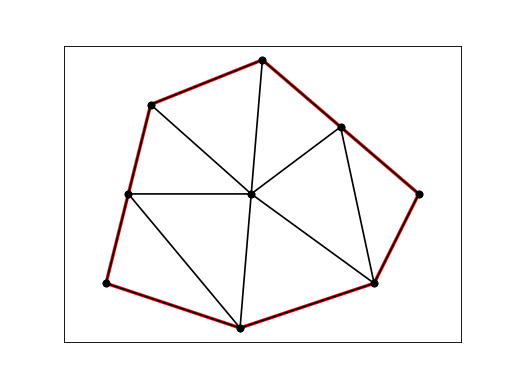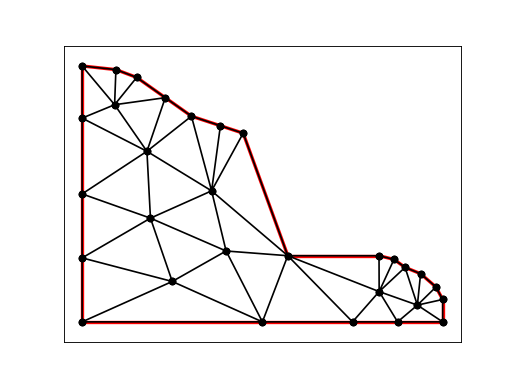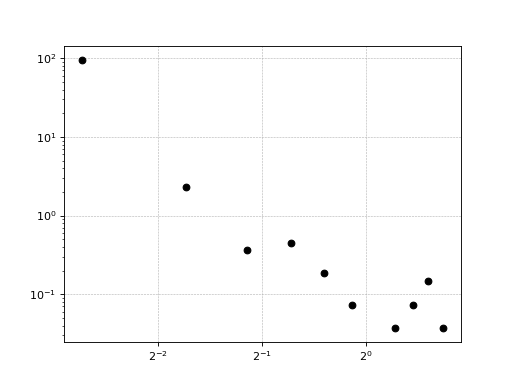3. circlespacking module¶
Module to define particular circular tangents in a closed polygon in \(\mathbb{R}^2\).
-
class
circlespacking.pckCirclesInPolygon(coordinates, depth=None)[source]¶ Bases:
objectCreates an instance of an object that defines circular particles tangent in a fractal way inside of a closed polygon in \(\mathbb{R}^2\).
-
coordinates¶ (n, 2) numpy.ndarray – Coordinates of vertices of the polygon.
-
depth¶ int – Depth fractal for each triangle that compose the triangular mesh. If this number is not given, then, the fractal generation of circles is done up to a circle reachs a radius to lower than the five percent of the incircle radius. Large values of depth might produce internal variables that tend to infinte, then a
ValueErroris produced with a warning messagearray must not contain infs or NaNs.
Note
The class
pckCirclesInPolygonrequires NumPy, Matplotlib and TriangleExamples
>>> from numpy import array >>> from circlespacking import pckCirclesInPolygon >>> coords = array([[1, 1], [2, 5], [4.5, 6], [8, 3], [7, 1], [4, 0]]) >>> pckCircles = pckCirclesInPolygon(coords) >>> pckCircles.__dict__.keys() dict_keys(['coordinates', 'depth', 'CDT', 'listCircles'])
-
trianglesMesh()[source]¶ Method to generate a triangles mesh in a polygon by using Constrained Delaunay triangulation.
Returns: Vertices of each triangle that compose the triangular mesh. n means the number of triangles; (3, 2) means the index vertices and the coordinates (x, y) respectively. Return type: verts ((n, 3, 2) numpy.ndarray) Examples
>>> from numpy import array >>> from basegeometry import Polygon >>> from circlespacking import pckCirclesInPolygon >>> coordinates = array([[1, 1], [2, 5], [4.5, 6], [6, 4], [8, 3], [7, 1], [4.5, 1], [4, 0]]) >>> polygon = Polygon(coordinates) >>> boundCoords = polygon.boundCoords >>> pckCircles = pckCirclesInPolygon(boundCoords) >>> verts = pckCircles.trianglesMesh()
>>> from numpy import array >>> from basegeometry import Polygon >>> from circlespacking import pckCirclesInPolygon >>> coordinates = array([[2, 2], [2, 6], [8, 6], [8, 2]]) >>> polygon = Polygon(coordinates) >>> boundCoords= polygon.boundCoords >>> pckCircles = pckCirclesInPolygon(boundCoords) >>> verts = pckCircles.trianglesMesh()
-
generator()[source]¶ Method to generate circular particles in each triangle of the triangular mesh.
Returns: list that contain all the circles object packed in the polygon. Return type: listCircles (list of Circle objects) Examples
>>> from numpy import array >>> from circlespacking import pckCirclesInPolygon >>> coords = array([[2, 2], [2, 6], [8, 6], [8, 2]]) >>> pckCircles = pckCirclesInPolygon(coords) >>> lstCircles = pckCircles.generator() # list of circles
-
plot(plotTriMesh=False)[source]¶ Method for show a graphic of the circles generated within of the polyhon.
Parameters: plotTriMesh (bool) – Variable to check if it also want to show the graph of the triangles mesh. The default value is FalseExamples
>>> from numpy import array >>> from basegeometry import Polygon >>> from circlespacking import pckCirclesInPolygon >>> coordinates = array([[1, 1], [2, 5], [4.5, 6], [6, 4], [8, 3], [7, 1], [4.5, 1], [4, 0]]) >>> polygon = Polygon(coordinates) >>> boundCoords = polygon.boundCoords >>> pckCircles = pckCirclesInPolygon(boundCoords) >>> pckCircles.plot()
>>> from slopegeometry import AnthropicSlope >>> from circlespacking import pckCirclesInPolygon >>> slopeGeometry = AnthropicSlope(12, [1, 1.5], 10, 10) >>> boundCoords = slopeGeometry.boundCoords >>> pckCircles = pckCirclesInPolygon(boundCoords) >>> pckCircles.plot(plotTriMesh=True)
-





